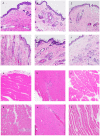Insights from computational modeling in inflammation and acute rejection in limb transplantation
- PMID: 24926998
- PMCID: PMC4057425
- DOI: 10.1371/journal.pone.0099926
Insights from computational modeling in inflammation and acute rejection in limb transplantation
Abstract
Acute skin rejection in vascularized composite allotransplantation (VCA) is the major obstacle for wider adoption in clinical practice. This study utilized computational modeling to identify biomarkers for diagnosis and targets for treatment of skin rejection. Protein levels of 14 inflammatory mediators in skin and muscle biopsies from syngeneic grafts [n = 10], allogeneic transplants without immunosuppression [n = 10] and allografts treated with tacrolimus [n = 10] were assessed by multiplexed analysis technology. Hierarchical Clustering Analysis, Principal Component Analysis, Random Forest Classification and Multinomial Logistic Regression models were used to segregate experimental groups. Based on Random Forest Classification, Multinomial Logistic Regression and Hierarchical Clustering Analysis models, IL-4, TNF-α and IL-12p70 were the best predictors of skin rejection and identified rejection well in advance of histopathological alterations. TNF-α and IL-12p70 were the best predictors of muscle rejection and also preceded histopathological alterations. Principal Component Analysis identified IL-1α, IL-18, IL-1β, and IL-4 as principal drivers of transplant rejection. Thus, inflammatory patterns associated with rejection are specific for the individual tissue and may be superior for early detection and targeted treatment of rejection.
Conflict of interest statement
Figures





References
-
- Cendales LC, Kanitakis J, Schneeberger S, Burns C, Ruiz P, et al. (2008) The Banff 2007 working classification of skin-containing composite tissue allograft pathology. Am J Transplant 8: 1396–1400. - PubMed
-
- Kanitakis J, Jullien D, Nicolas JF, Frances C, Claudy A, et al. (2000) Sequential histological and immunohistochemical study of the skin of the first human hand allograft. Transplantation 69: 1380–1385. - PubMed
-
- Kanitakis J (2008) The challenge of dermatopathological diagnosis of composite tissue allograft rejection: a review. J Cutan Pathol 35: 738–744. - PubMed
-
- Schneeberger S, Gorantla VS, van Riet RP, Lanzetta M, Vereecken P, et al. (2008) Atypical acute rejection after hand transplantation. Am J Transplant 8: 688–696. - PubMed
Publication types
MeSH terms
Substances
LinkOut - more resources
Full Text Sources
Other Literature Sources
Miscellaneous

